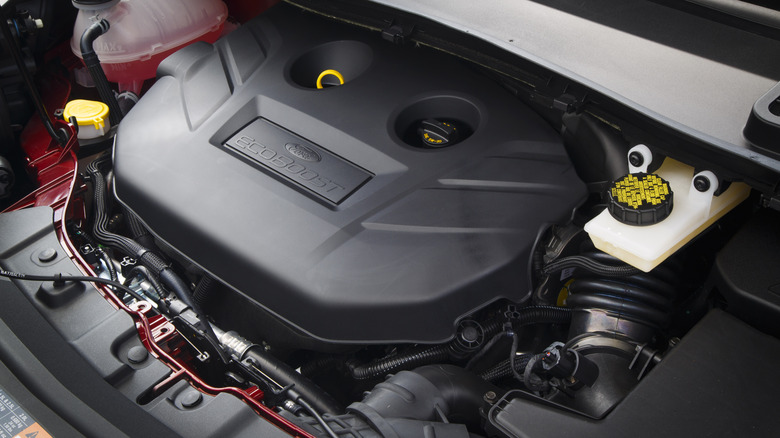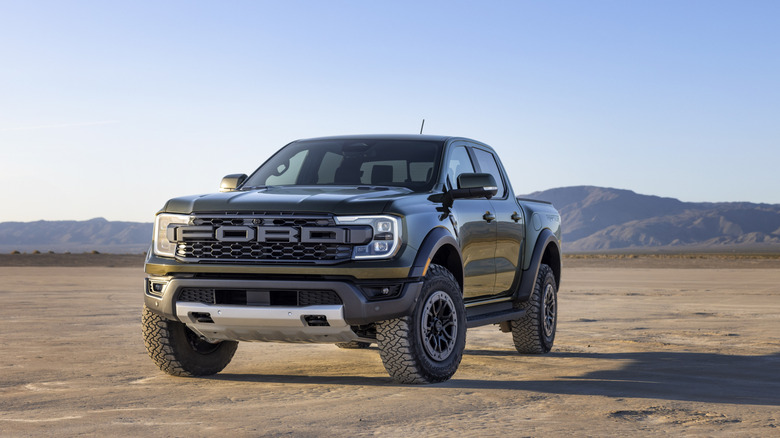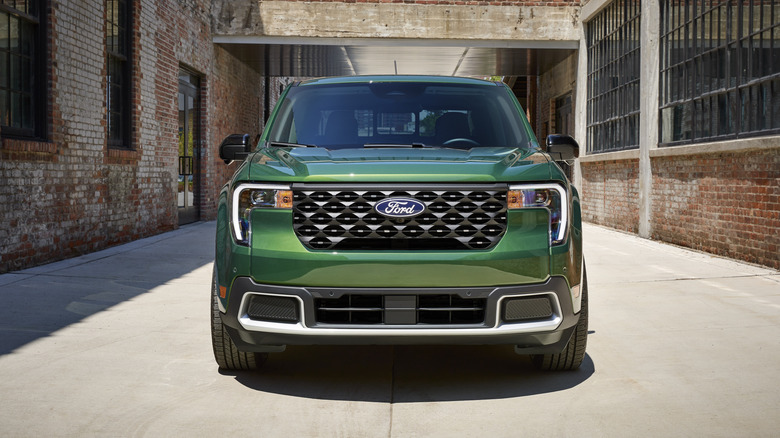Does The EcoBoost Engine Require Premium Gas? Here's Which Rating Ford Recommends
EcoBoost engines have been integral to Ford's lineup since the 2010 model year, with engines like the 3.0-liter EcoBoost powering a range of Ford vehicles, including the Explorer ST and Bronco Raptor. Like any engine, using fuel with a recommended octane rating is essential to keep an EcoBoost running smoothly. But it's also important to remember that using premium fuel when it's not necessary is a waste of money.
In May 2025, the average difference between regular and premium gasoline was $0.94 per gallon, as reported by the U.S. Energy Information Administration (EIA). At those prices, filling up an empty 18-gallon fuel tank with high-octane gas costs $16.92 extra, which works out to nearly $880 annually, assuming weekly stops at the pump. For context, the EIA categorizes regular-grade fuel as having an octane rating of 87, while mid-grade ranges from 89 to 91 octane. Premium fuel, meanwhile, has an octane rating of 91 to 94.
We've compiled information on the fuel octane ratings required across a broad spectrum of EcoBoost engines ranging from three to six cylinders. These turbo powerplants are used in numerous newer Ford models, including the F-150, Escape, Bronco Sport, and Maverick, and appeared in discontinued models like the Fusion and Fiesta. All will run on regular, but Ford recommends premium gas for the best performance.
V6 EcoBoost fuel requirements
The largest EcoBoost engine Ford offers is the 3.5-liter V6. Among 2025 Fords, it's found in the Expedition and F-150, making 400 to 440 hp, depending on the model and trim. A detuned version making 310 hp is optional in the Transit van. Ford recommends using 91-octane fuel for best overall performance, especially when towing. The downsized 3.0-liter EcoBoost V6, which is the subject of a class-action lawsuit, is also found in many newer Ford models such as the Bronco Raptor and Explorer. Like the larger 3.5-liter unit, this 400 to 418-hp engine can run on 87-octane gasoline, even in the 405-hp Ranger Raptor. Ford does state that infrequent light engine knocking is normal, an advisory that accompanies the other EcoBoost units we're discussing.
A 2.7-liter unit completes Ford's EcoBoost V6 trio. It's available as standard or optional equipment in 2025 versions of the Ford F-150, Bronco, and Ranger, where it makes 315 to 330 hp. Ford says that 87-octane gasoline is acceptable for this engine, but premium gas is the best fuel for maximum performance. All V6 EcoBoost engines have twin turbochargers.
Three- and four-cylinder EcoBoost fuel requirements
Ford also uses multiple smaller EcoBoost engines (which all use a single turbocharger) in its cars. The four-cylinder 2.3-liter EcoBoost is the base engine in the Bronco, Explorer, and Mustang, with output between 300 to 315 hp. Meanwhile, Ford offers the four-cylinder 2.0-liter EcoBoost, which makes 250 hp, in higher-trim versions of the Escape, Bronco Sport, and Maverick. The smallest EcoBoost currently sold in the U.S. is the three-cylinder 1.5-liter engine, which produces 180 hp in the Escape and Bronco Sport. Like their V6 EcoBoost counterparts, Ford recommends 87-octane gasoline at a minimum, with drivers getting better performance if they fill the tank with at least 91-octane premium.
Ford also has many now-discontinued models that once used EcoBoost engines. Starting in 2014, the Fiesta's engine lineup included a three-cylinder 1.0-liter and a four-cylinder 1.6-liter EcoBoost, depending on the year. In 2015, Ford added the 1.0-liter EcoBoost to the Focus's engine bay, with EcoBoost options expanding two years later to include 2.0- and 2.3-liter units. The first EcoBoost debuted in the Fusion for the 2013 model year — the launch of the second generation — in 1.6- and 2.0-liter forms. A four-cylinder 1.5-liter EcoBoost was added a year later. In 2017, Ford added twin-turbo 2.0-liter four-cylinder and 2.7-liter V6 EcoBoosts to the options list. Once again, the octane requirements for these historical models were the same as current EcoBoost vehicles: at least 87 octane, but 91 was better.


